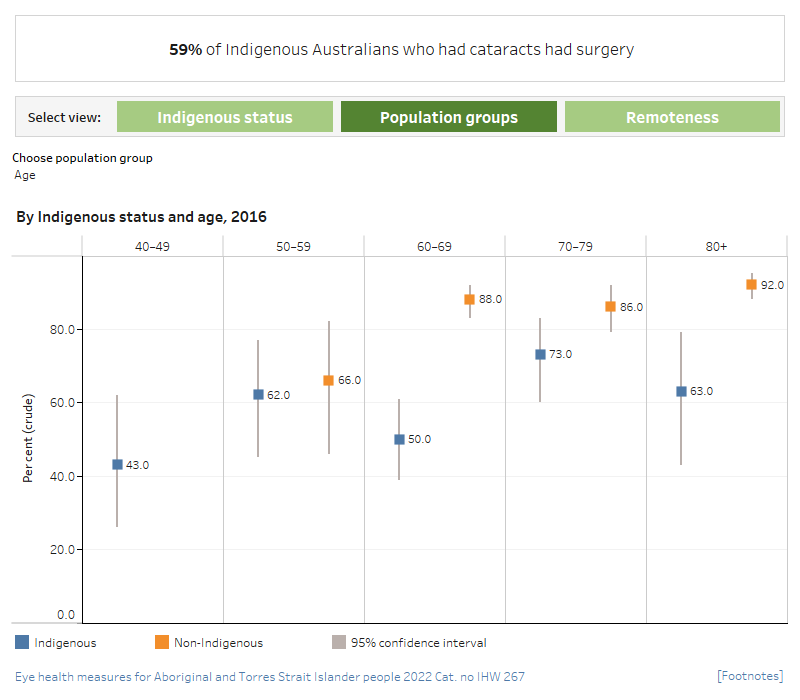Cataract surgical coverage rate (NEHS)
Measure 3.5.1: The cataract surgical coverage rate, expressed as the number of Indigenous Australians who have had cataract surgery, as a proportion of those who have had cataract surgery plus those who have vision loss (visual acuity worse than 6/12) and cataracts in 1 or both eyes (National Eye Health Survey definition).
The coverage rate captures those with the condition who have and have not had cataract surgery.
Figure 3.5.1: Cataract surgical coverage rate (NEHS)
There are 4 separate charts showing cataract surgery coverage and confidence intervals, by various characteristics. The data is presented as a scatter plot for the point estimate and Gant chart representing the confidence interval.
Cataracts surgery coverage rate by Indigenous status, 2016
This combined scatter plot and Gant chart compares cataract surgery coverage, by Indigenous status. The chart shows that, in 2016, the cataract surgical coverage rate for Indigenous participants in the 2016 NEHS was 59%. This was significantly lower than the rate for non-Indigenous participants (89%).
Cataracts surgery coverage rate by Indigenous status and age, 2016
This combined scatter plot and Gant chart compares cataract surgery coverage in 2016, by Indigenous status and by age group. The chart shows that cataract surgical coverage rates for Indigenous participants did not differ significantly by age group. Excluding those aged 40─49 (where there was no data), non-Indigenous cataract surgery coverage was higher than that for Indigenous Australians across all age groups.
Cataracts surgery coverage rate by Indigenous status and sex, 2016
This combined scatter plot and Gant chart compares cataract surgery coverage in 2016, by Indigenous status and by sex. Among Indigenous Australians, the rate was higher among males than females (69% and 52%)—however there was no sex related difference among non‑Indigenous Australians (88% for both).
Cataracts surgery coverage rate by Indigenous status and region, 2016
This combined scatter plot and Gant chart compares cataract surgery coverage in 2016, by Indigenous status and by remoteness. The chart shows that cataract surgical coverage rates for Indigenous participants did not differ significantly by remoteness (due to large confidence intervals). Non-Indigenous cataract surgery coverage was higher than that for Indigenous Australians in each remoteness category.

- In 2016, the NEHS cataract surgical coverage rate for Indigenous Australians was 59%. This was significantly lower than the rate for non-Indigenous Australians (89%).
- In 2016, the estimated cataract surgical coverage rate for Indigenous Australians was lowest for those aged 40–49 (43%) and highest for those aged 70–79 (73%). The surgical coverage rate for non-Indigenous Australians was significantly higher than for Indigenous Australians, for those aged 60–69 and for those aged 80 or over.


